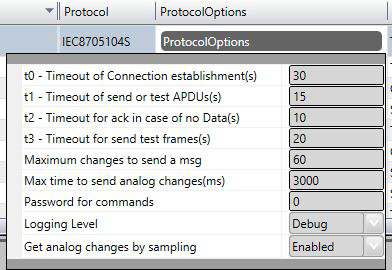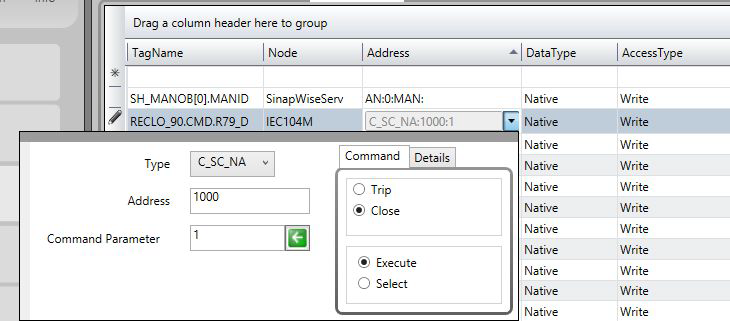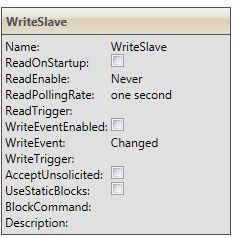Page Tree
Other Releases
Page Tree
Other Releases
The IEC870504S protocol implements communication with client stations compatible with this protocol, acting as a slave station (server).
Communication Driver Name: IEC8705104S
Current Version: 2016.2.1
Implementation DLL: T.ProtocolDriver.IEC8705104S.dll
Protocol: IEC-60870-5-104 Slave standard protocol
Interface: TCP/IP
Clients types supported: Any IED compatible with IEC-60870-5-104
Communication block size: Maximum 253 bytes
Protocol Options: Counters used for sending protocol control messages
Multi-threading: User defined. Five threads per node by default
Max number of nodes: User defined
PC Hardware requirements: Standard PC Ethernet interface board
The protocol uses the same ASDUs and object data types that are defined for IEC-60870-5-101. The major difference is that this is only targeted towards network orientation, using TCP/IP as the transport layer.
Plus all the variant of the ASDUs above with a 56-bit timestamp. The above codes are used for point registration. When sending unsolicited changed, the variants with a date and timestamp obtained from the tags contained in the memory.
This communication module implements the IEC-60870-5-104 protocol in Slave mode and communicates with IEDs that use the same protocol in Master mode. Several parameters are available to accommodate different profiles of protocol implementations.
Slave mode has the following operating sequence:
This module answers to variable reading – analog and digital -, event transmission and command execution requests. The implementation has the following characteristics:
t0 - Timeout of Connection establishment(s) – Maximum waiting time, in seconds, for a
client TCP/IP to establish a connection with the LISTENING port. After this time, this driver
actively closes the TCP/IP socket and restarts it to a LISTENING state. Allowed values are
between 1 and 255.
t1 - Timeout of send or test APDUs(s) - Maximum acceptable time, in seconds, for the
slave to send regular or test APDUs after receiving the START DT sending confirmation.
Allowed values are between 1 and 255.
t2 - Timeout for ack in case of no data(s) - Maximum waiting time, in seconds, for a
pending acknowledgement before sending an acknowledgement for the last received
message. A message with the sequence number of the last one received. Values from 1 to
255 are allowed. In addition, t2 must be shorter than t1.
t3 - Timeout for send test frames(s) - Maximum waiting time, in seconds, for the arrival of
any information (in case of a TCP-IP connection already established) before sending a
TEST-FR. The values are allowed are from 1 to 255.
Maximum Changes to send a message - To improve communication module performance
when sending changes in analog measurements, this number can be set as the maximum
number of changes that must be accumulated to be sent in a single message, instead of
sending a measure in each message. A number considered good is 30 measures, which is
the default value. This accumulation is used when tag changes, in measurements, are
received by the communication module as events (AccessType with WriteEventEnable).
Max time to send analog changes (ms) – This defines the maximum waiting time for
sending a message with changes in analog measurements. If, since the start of
accumulation of measurements for the same message, this time expires before the arrival
of the number of measures defined above, this module will send the message with the
measures that have already arrived. This time is set to 3 seconds. If the “Get analog changes
by sampling mode” option is used (see below), this is the time to be used as the interval
between two samplings.
Password for commands : In order to increase security when sending commands, normally
initiated only by a change in the state of a tag, it is possible to specify in the Client modules
a password of up to 9 digits for the command. Here in this server module you must specify
the password used by this Server module to generate the command for the Client module
that will actually send the command to the field. This password must be the same as that
used by the module sender of this command.
| Logging Level | |
|---|---|
| Debug | All messages are registered in the LOG. |
| Info | Only Info, Warning and Error messages are registered in the LOG. |
| Warning | Only Warning and Error messages are registered in the LOG. |
| Error | Only Error messages are registered in the LOG. |
Get analog changes by sample - Alternatively to the mode of receiving changes of tag
values, (by using AccessType with WriteEventEnable), there’s an option to use, by the
communication module, the sampling mode of changes occurred in tags. In this mode, the
current values are checked against the last values sent periodically. This way only the
change is considered, and the new value is sent to the client, if the absolute difference
between the current value and the last one sent is greater than the Deadband attribute of
the tag. To use this mode you must use the AccessType in the Points table, for these
measurement tags, with WriteEventEnable disabled.
The time interval between each of the two checks will be as defined in the above parameter,
Max time to send analog changes (ms).

Listening Port : Number of the port used for listening client connection attempts. The standard defines port 2404 , by default. User can use custom port numbers.
NodeConnections : Defines the maximum number of parallel requests that could be sent to each node (asynchronous communication).
Each node is a server station (IED). User may set a single station per channel.
CommonAddress - Application Layer address.
w – Send ack after received w IFormatAPDUs – Number of information messages sent
spontaneously to client until it sends an “acknowledgment” with the sequence number of
the last messages it received. Allowed values are between 1 and 32767.
k – Messages received to send state variable – Maximum allowed number of pending
acknowledgements before this slave stops sending new messages. The IEC standard
recommends that w is, at most, two-thirds of the k value. Values allowed are between 1
and 32767.
Clock Adjust – Can be set as “True” to adjust the clock on this server computer or “False” to
make no adjustment. This module will adjust the clock by changing the machine time to
match the one that came on a synchronization message received. For this to be effective,
the master IED must send a time that comes, for example, from a GPS.
Tag for Comm status - In this field the name of an existing tag in the project can be
indicated to show success/failure in communication from a functional point of view. The
module waits for a maximum of Timeout milliseconds (defined in Protocol Options, as t2
above) for receiving a request from the client. In case of failure, the module sets the value of
this tag to ZERO. In case of success, it sets the value to ONE.
Backup Station – The same settings adjusted to the main station can be adjusted to a
backup workstation (alternative IED) if there is one in the facility.

Points can be input or output points. Input points, i.e. points that are acquired by the
protocol, have basically two main parameters: point type and address. Output points used
for remote controls have an additional address field parameter to specify an output
operation. In a given IED or Node all addresses are unique no matter the kind of point.
Scada in Slave mode implements:
The implemented point types are defined by the data objects set out in the IEC standard, presented below:
M_SP_NA: 1 - Single-point information
M_DP_NA: 3 - Double-point information
M_ST_NA: 5 - Step position
M_BO_NA: 7 - Bitstring with 32 bits
M_ME_NA: 9 - Measured value, normalized
M_ME_NB: 11 - Measured value, scaled value
M_ME_NC: 13 - Measured value short floating point
M_IT_NA: 15 - Integrated totals
C_SC_NA: 45 - Single command
C_DC_NA: 46 - Double command
C_RC_NA: 47 - Regulating step command
C_SE_NA: 48 - Set point command, normalized value
C_SE_NC: 50 - Set point command, short floating point value
C_BO_NA: 51- 32-bit Write Bitstring
The completion of point addresses is performed in the engineering environment, in Edit>
Devices> Points.
The Address field to be filled in during point registration is what the standard calls
“Information Object Address.” This is a number of 3 bytes. For a given IED (node), it must be
unique.
As shown in the figure below, clicking once on the row of the address column will open a
window to select the type and address of the point. Clicking on the type will open a window
with all types of points supported:

To select Type:

The command parameter applies only to commands types and is a one-byte code which
details what and how the IED should execute the command. In this implementation, as the
user registers a point typed as command output, this field shows up to the user. If the user
already knows the code, then he or she can just type it in the field. Otherwise, they must
click on the button to the right of the window to display a dialog to choose the actions and
details of commands.
Parameter Configuration
The codes generated by choosing the items in the window parameter setting command are
formed by calculating the sum of two parts (A and B), with the first part indicating the
action, and the second indicating the details of the transaction, as defined below:
For Single Command C_SC_NA:
For Double Command C_DC_NA:
For Voltage Regulation C_RC_NA:
The remaining options are the Select command - just select the device to be controlled, or
the Execute command – which means sending the action command itself. For the Select ,
128 must be added to the code obtained from the sum of the parts A and B.
Example: code = 9 in a simple command means Long Pulse to Turn on the remote device.
Using the parameter in the Server (Slave) protocol
When receiving a master (client) command, the server runs according to the parameter
coming from the message. The parameter defined on the data base of the server is not
used and can be set in any way desired by the user.
The behavior of the server when executing a command is as follows:
Select / Execute
SELECT – There will be no execution per se, i.e., there will be change in server memory. A
message will be sent to the log (Trace), indicating the SELECT mode, if the output
point was actually found on the server. If the point doesn’t exist, a “POINT NOT
FOUND” error message will appear in the log.
EXECUTE - The command will be executed normally and an “EXECUTE” message will appear
in the log.
Detail Options – Option B
0 – No detail – The destination point state of the command will be toggled (if zero, it
changes to 1 and if 1 it changes to zero), whatever the value of part A.
4 – Short Pulse – The value of part A will be placed at the destination point, maintained this
way for 100 ms, and then restored to its original value.
8 – Long Pulse – The value of part A will be placed into the destiny point, maintained this
way for 1000 ms, and then restored to its original value.
12 – Persistent Signal – The value of part A will be placed at the destination point and kept
this way.
In order to set up the Scada with output parameters, follow the procedure below: (1) Click the right border of the address once to show three command parameters in the command tab:
And the command options:
(2) Select the desired options and by clicking on the left arrow ( ), the binary value
corresponding to the selection will be loaded in the command parameter:

If detailing the type of signal to be sent is necessary, before clicking on the left arrow click
on details and, as in the figure below, select the type of the output signal:

Since this is a slave (server) communication module, it requires a few specific characteristics
of its own in order to parameterize the Access Type field in the Points table:
For reading-type points: (using WriteEvents enabled, receiving changes as events)
The Access Type must be defined with:

For reading-type points, used as analog measures (Using Get analog changes by sampling mode)
AccessType must be defined as shown in the SlaveAna figure below.

For output commands-type points:
AccessType must be defined as: (WriteSlave)
